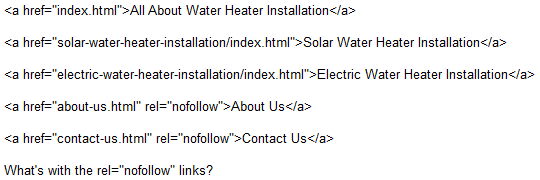Perhaps one of the more overlooked SEO practices; navigation menu optimization offers site owners an advantage over competing sites with minimal effort and high-gain potential. In the following entry, we will take a closer look at this area in hopes of extending your SEO reach.
Let’s start out with a simple example, shall we?
Say you want to link to a page on your water heater installation site that focuses on solar water heater installation. Your primary keyword phrase for this particular page will likely be “solar water heater installation.” Best practices tell us that we should use this phrase, “Solar Water Heater Installation” when linking to said page. This is an example of anchor text optimization. Unfortunately, in the pursuit of creativity, many people choose not to utilize proper practices in regard to anchor texts during link building.
Take a peak at how your links should look when proper practices are employed:
Full navigation menu practices – Example #2
In this example, we will use the following navigation links:
– All About Water Heater Installation
– Solar Water Heater Installation
– Electric Water Heater Installation
– Gas Water Heater Installation
– About Us
– Contact Us
For the purpose of this example, “Solar Water Heater Installation”, “Electric Water heater Installation” and “Gas Water Heater Installation”, will all link to main areas of your website. From these pages, you would typically create sub-pages complete with additional information pertaining to these particular products and services.
In addition, it’s always a good idea to position pages with like topics in a unique directory, naming said directory with a dedicated keyword phrase that pertains to that area.
With these lessons in mind, the following are examples of how your navigation menu should look:
No-follow attributes are used in main navigation links that are not deemed particularly relevant to the website’s unified theme. By removing generic links, such as “About Us” and “Contact Us”, you serve the site by redistributing page ranks to pages that may hold more value.
Choosing to utilize proper keyword phrasing and sub-directories within your navigation menu is vital in ensuring higher page ranks, while helping search engines to better assess what your site is actually about. Though it may appear in your best interests to title pages and links with creative phrasing, it will ultimately work against you, leading search engines astray and lowering your potential traffic.
If you’re still in the dark, please feel free to contact an Eminent SEO representative to discuss your website optimization options!




There seems to be two schools of thought about using the nofollow tag on internal links such as you proposed. It’s thought that google will see this as a way to manipulate pagerank. I’m not sure I believe that yet. Do you have any thoughts on it? Thanks
Never thought of that before. But great stuff!
Let say my domain is www. bhis.com.au
And i had make a nav page: http:// bhis.com.au/pre-purchase-building-inspections-perth/
is it a good practice?
Hi, Peter. Thanks for submitting your question.
We see where you’re going with putting your keyword into your URL, but that’s actually not the best practice. It’s best to organize your nav pages simply. So, in your case, you should probably just end your URL with /inspections/
You definitely don’t need to have the city name in there, unless you have an inspections sub-page for several different cities. Hope this helps. Thanks for dropping by!
pretty straight forward, simple. thanks.
Thanks for reading, Josh!
Good post, I will implement the recommendations on my website soon
Thanks for sharing
Thanks for reading, James, and glad we could help. Let us know if we can help in any other way.
I am new to this so this I am sure is a newbie question. first thank you for your post it is pretty straight forward. the part that actually confused me is your links.
solar-water-heater-installation/index.html
and
electric-water-heater-installantion/index.html
Why did you type them this way? Should it be:
index.html/solar-water-heater-installation
and
index.html/electric-water-heater-installation
since solar water heater installantion and the electric water heater installation pages are within the index.html folder?
I don’t think I have ever seen links with this kind of reversal, but I know you are heck of a lot smarter than me, so is the way you have written the link better for SEO?
Thank you
good write up on optimizing menu for seo.
Thank you for reading, Christopher! We invite you to check out some of our newer posts and let us know what you think. For example, this is our latest post on an SEO-specific topic: https://chris.wpengine.com/blog/how-website-pop-ups-chip-away-seo-progress/
thanks for your valuable article….its really very helpful for newbie
Glad you enjoyed it and found it valuable! Feel free to check out some of our newer posts and let us know what you think.